There are numerous ways in which digital ads can be targeted on YouTube. This includes “contextual targeting” and “audience targeting”.
In Google’s documentation on “How audience targeting works”, it says:
“audiences are made up of segments, or groups of people with specific interests, intents, and demographic information, as estimated by Google. When adding an audience to a campaign or ad group, you can select from a wide range of segments. For example, these segments could include fans of sport and travel, people shopping for cars, or specific people that have visited your website or app. Google Ads will show ads to people who are likely in the selected categories. Users are allocated into audience categories for targeting on third-party websites and apps based primarily on their activity on third-party websites and apps. Users are allocated into audience categories for targeting on Google’s own products based primarily on their activity on these products.”
When advertisers pay for ads to be served with “audience targeting” data, they get access to “Audience reporting” in their Google Ads dashboards. This includes “Reports on how well you are targeting groups of people with specific interests and intents.” One example of audience segments is “affinity segments”, which include “targeting based on people’s interests and habits.”
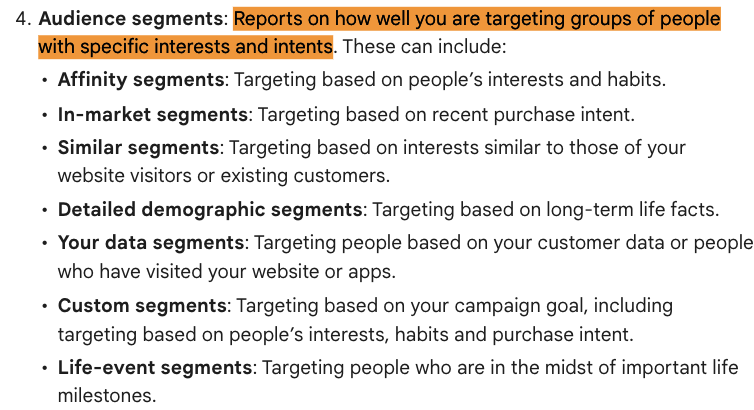 Source: Google Ads Help – “About Audience reporting”
Source: Google Ads Help – “About Audience reporting”YouTube’s CEO wrote in 2019 that the platform:
- “will also stop serving personalized ads on [made for kids] content entirely”
- “will treat data from anyone watching children’s content on YouTube as coming from a child, regardless of the age of the user”
However, multiple media buyers shared Google Ads campaign reports with Adalytics that raise questions about the YouTube CEO’s commitments.
Behaviorally targeted ad campaign #1 serving ads on “Made for Kids” channels
A media buyer configured a YouTube ad campaign to target several dozen different user audience segments. These included both “Life events” – such as “Recently Started a Business”, and “Affinity segments”, such as “Business Travelers”. The media buyer did not select or enable “audience expansion”.
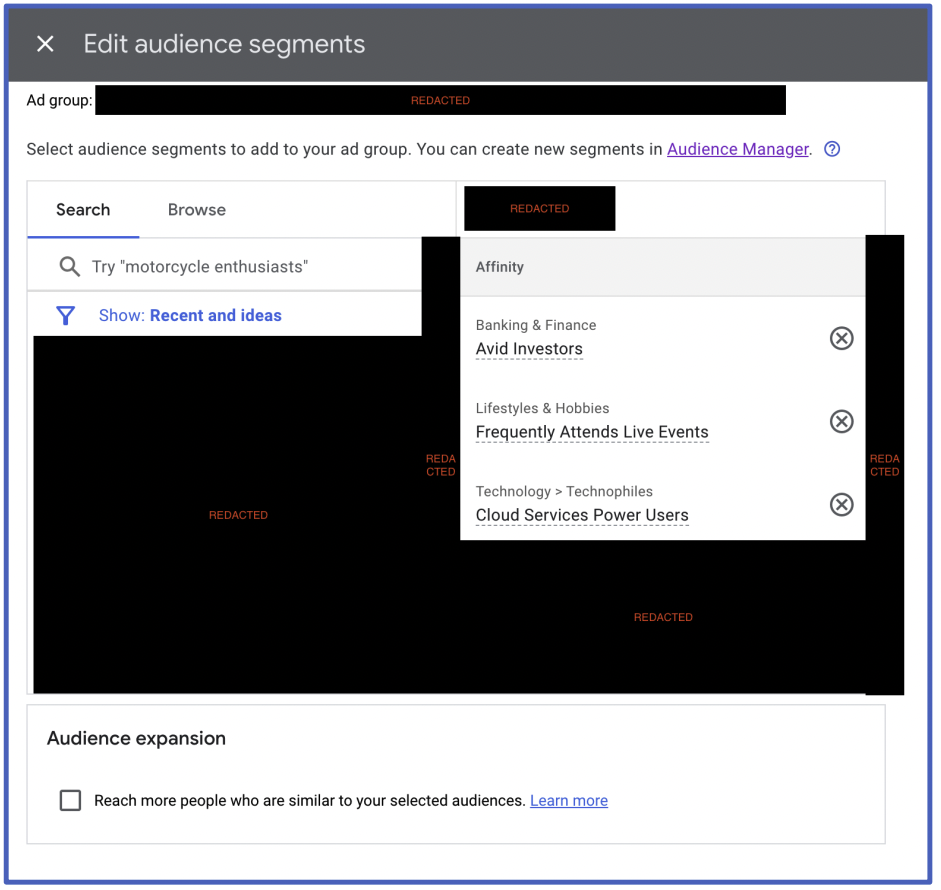 Screenshot of the Google Ads dashboard, showing specific Audience segments selected for ad targeting and delivery in the ad buy configuration. (Note: Un-redacted screenshots can be shared with readers in confidence).
Screenshot of the Google Ads dashboard, showing specific Audience segments selected for ad targeting and delivery in the ad buy configuration. (Note: Un-redacted screenshots can be shared with readers in confidence).Google’s documentation states that “Life events” allow advertisers to “Reach users when they're in the midst of important life milestones”, and “Affinity segments” enable advertisers to “Reach users based on what they're passionate about and their habits and interests.”
In the absence of a control to exclude “made for kids” content specifically, the media buyer elected to exclude “Content Suitable for Families” in their Google Ads dashboard. The media buyer also excluded the “Google Video Partner” (GVP) network.
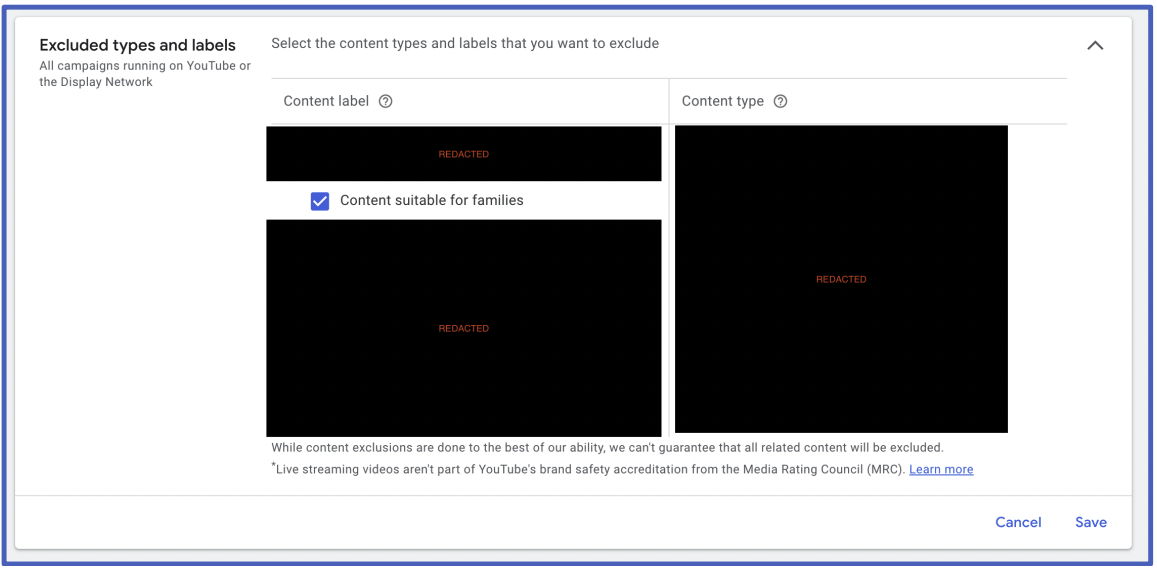 Screenshot of the Google Ads dashboard, showing “Content suitable for families” has been excluded for the ad buy configuration. (Note: Un-redacted screenshots can be shared with readers in confidence).
Screenshot of the Google Ads dashboard, showing “Content suitable for families” has been excluded for the ad buy configuration. (Note: Un-redacted screenshots can be shared with readers in confidence).Furthermore, the buyer configured their targeted audience demographics to exclude users that Google has identified as a “Parent”.
 Screenshot of the Google Ads dashboard, showing that the ad campaign is configured to avoid having ads served to users for whom Google’s data shows the viewer is a “Parent”. (Note: Un-redacted screenshots can be shared with readers in confidence).
Screenshot of the Google Ads dashboard, showing that the ad campaign is configured to avoid having ads served to users for whom Google’s data shows the viewer is a “Parent”. (Note: Un-redacted screenshots can be shared with readers in confidence).The media buyer inputted a list of several hundred “made for kids” YouTube channels as part of an “inclusion list” of channels to target for the campaign.
After the ad campaign had begun serving, the media buyer downloaded a detailed Placement report, audience segment report using “audience reporting”, and demographic report to analyze their YouTube ad campaign performance. These reports were shared with Adalytics.
The placement report revealed that 100% of the impressions and views generated by this behaviorally targeted ad campaign were served on “made for kids” channels such as “Boys Playtime”.
 Screenshot of the Google Ads campaign placement reports, showing that the ad campaign had ads served on various “Made for Kids” YouTube channels such as “Boys Playtime”. (Note: Un-redacted screenshots can be shared with readers in confidence).
Screenshot of the Google Ads campaign placement reports, showing that the ad campaign had ads served on various “Made for Kids” YouTube channels such as “Boys Playtime”. (Note: Un-redacted screenshots can be shared with readers in confidence).The audience segment report showed that 100% of the YouTube video ad impressions were served to users based on various (personalized) behavioral “life events” and “affinity segments”, such as “Business Travelers”.
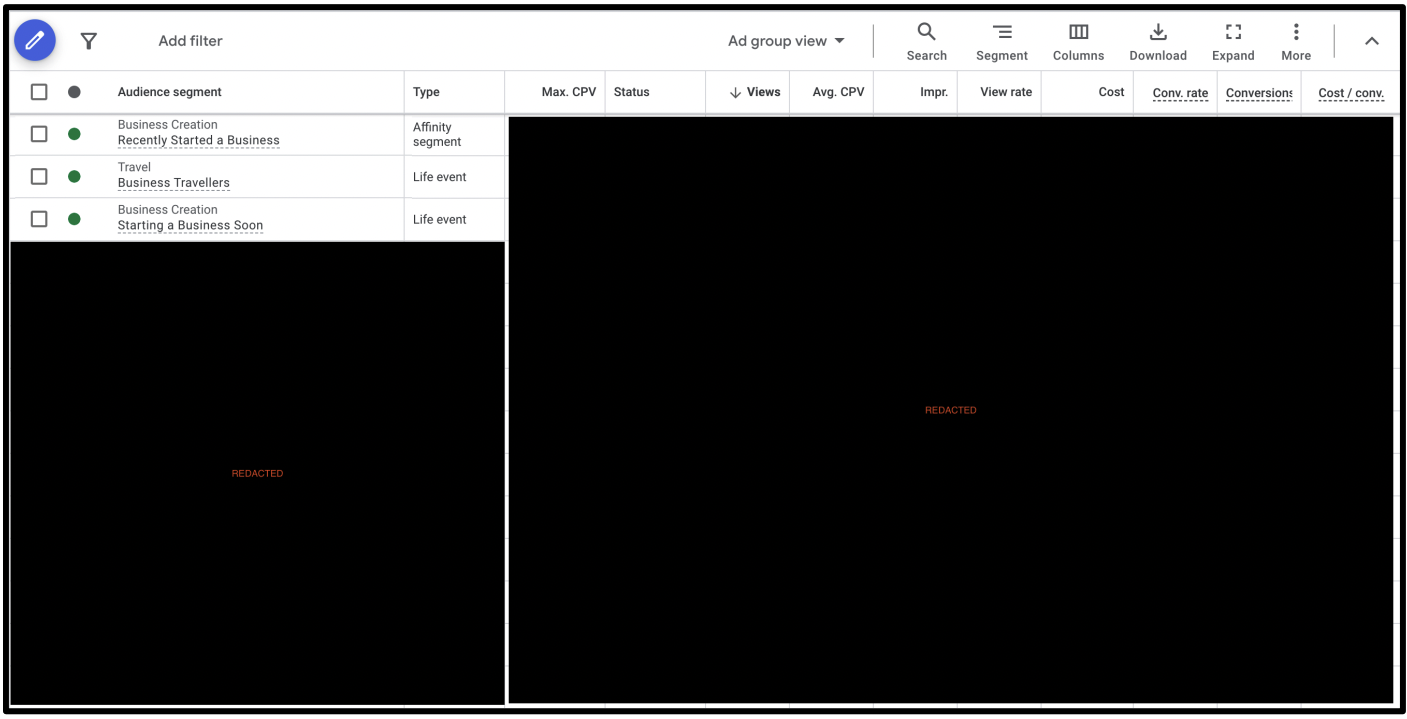 Screenshot of the Google Ads campaign placement reports, showing that the ad campaign had ads served to various user behavioral audience segments, such as “Business Travelers” or users who are “Starting a Business Soon”. (Note: Un-redacted screenshots can be shared with readers in confidence).
Screenshot of the Google Ads campaign placement reports, showing that the ad campaign had ads served to various user behavioral audience segments, such as “Business Travelers” or users who are “Starting a Business Soon”. (Note: Un-redacted screenshots can be shared with readers in confidence).The demographic report showed that 100% of the YouTube ad impressions were served to users who were not parents according to Google’s data.
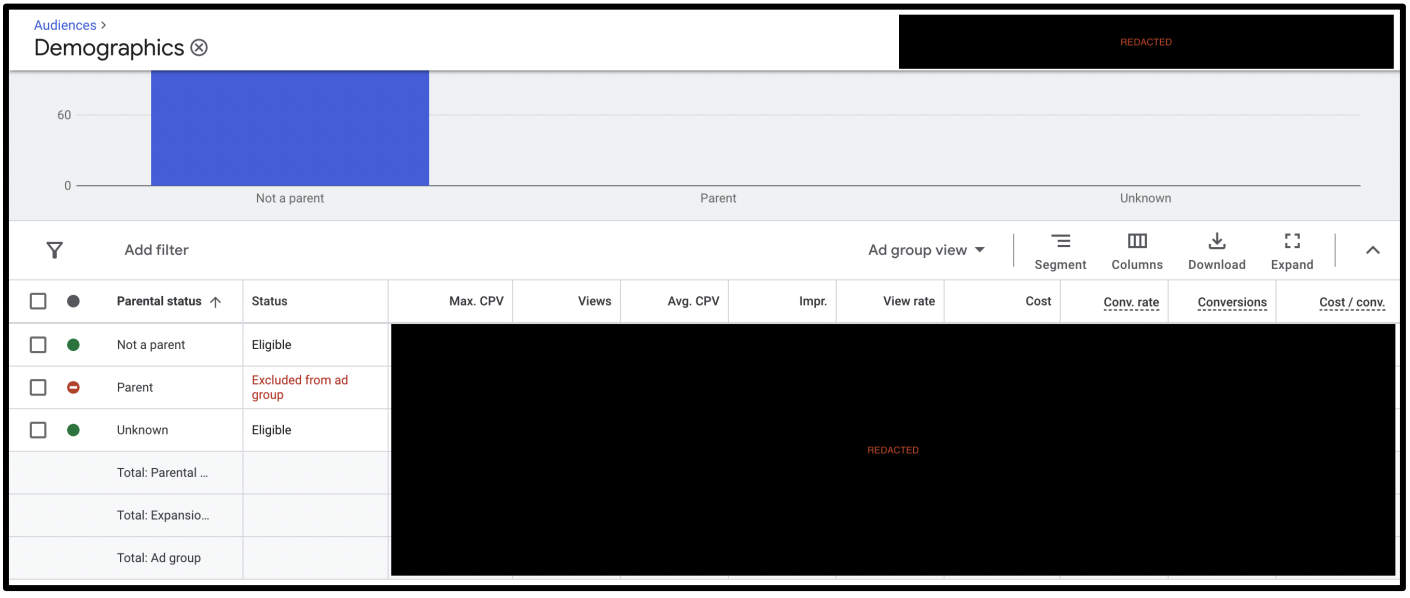 Screenshot of the Google Ads campaign placement reports, showing that the ad campaign was entirely served to consumers who are either “Not a parent”, or for whom Google has no data showing whether the given individual is a parent (“Unknown” “Parental status”). (Note: Un-redacted screenshots can be shared with readers in confidence).
Screenshot of the Google Ads campaign placement reports, showing that the ad campaign was entirely served to consumers who are either “Not a parent”, or for whom Google has no data showing whether the given individual is a parent (“Unknown” “Parental status”). (Note: Un-redacted screenshots can be shared with readers in confidence).It is unclear why or how these behaviorally personalized video ads were served on “Made for Kids” YouTube channels. These ad campaign results raise questions about the YouTube CEO’s statement that no personalized ads would serve on “made for kids” YouTube videos.
Campaign #2 - Behaviorally targeted ads serving ads on “Made for Kids” channels
A second media buyer configured a YouTube ad campaign to target several dozen different user audience segments. These included “Affinity segments”, such as “High-End Computer Aficionados”. The media buyer did not select or enable “audience expansion”. The media buyer inputted a list of several hundred “made for kids” YouTube channels as part of an “inclusion list” of channels to target for the campaign.
After the ad campaign had begun serving, the media buyer downloaded a detailed Placement report, audience segment report (using “audience reporting”), and demographic report to analyze their YouTube ad campaign performance. This second media buyer’s reports were shared with Adalytics, which analyzed the reports on behalf of the buyer in Python Jupyter notebooks.
The placement report revealed that 100% of the impressions and views generated by this behaviorally targeted ad campaign were apparently served on “made for kids” channels such as “stacyplays”.
 Data table showing a Google Ads placement report for a behaviorally targeted ad campaign, with the top YouTube channels by number of ads served. (Note: Un-redacted screenshots can be shared with readers in confidence).
Data table showing a Google Ads placement report for a behaviorally targeted ad campaign, with the top YouTube channels by number of ads served. (Note: Un-redacted screenshots can be shared with readers in confidence).The second media buyer’s audience segment reports showed that apparently 100% of the video ad impressions used some form of behavioral ad targeting. For example, 76.5% of ad impressions were served to consumers for whom Google has classified the individual user as a “High-End Computer Aficionados”.
 Data table showing a Google Ads audience segment report for a behaviorally targeted ad campaign. (Note: Un-redacted screenshots can be shared with readers in confidence).
Data table showing a Google Ads audience segment report for a behaviorally targeted ad campaign. (Note: Un-redacted screenshots can be shared with readers in confidence).The second media buyer’s demographic reports showed that only 2% of ad impressions were served to consumers for whom Google has data showing the user is a “Parent”. For 98% of impressions served, Google’s data shows the “Parental status” of the viewer is “Unknown”, or that the user is “Not a parent”.
 Data table showing a Google Ads demographic (“parental status”) report for a behaviorally targeted ad campaign. (Note: Un-redacted screenshots can be shared with readers in confidence).
Data table showing a Google Ads demographic (“parental status”) report for a behaviorally targeted ad campaign. (Note: Un-redacted screenshots can be shared with readers in confidence).Given that the second media buyer’s ad campaign appeared to have been 100% behaviorally targeted, it is unclear how it is possible their ads were served on “made for kids” YouTube channels. This may raise concerns about the YouTube CEO’s 2019 statement that no personalized ads would be served on “made for kids” videos.
Campaign #3 - Behaviorally targeted ads serving ads on “Made for Kids” channels
A third media buyer configured a YouTube ad campaign to target several dozen different user audience segments. These included “Affinity segments”, such as “Motorcycle Enthusiasts”. The media buyer did not select or enable “audience expansion”. Furthermore, the buyer configured their targeted audience demographics to exclude users for whom Google says the user is a “Parent”. The media buyer inputted a list of several hundred “made for kids” YouTube channels as part of an “inclusion list” of channels to target for the campaign.
After the ad campaign had begun serving, the media buyer downloaded a detailed Placement report, audience segment report (using “audience reporting”), and demographic report to analyze their YouTube ad campaign performance. The third media buyer’s reports were shared with Adalytics, which analyzed the reports on behalf of the buyer in Python Jupyter notebooks.
The placement report revealed that 100% of the impressions and views generated by this behaviorally targeted ad campaign were apparently served on “made for kids” channels such as “Miraculous Ladybug”.
 Data table showing a Google Ads placement report for a behaviorally targeted ad campaign, with the top YouTube channels by number of ads served. (Note: Un-redacted screenshots can be shared with readers in confidence).
Data table showing a Google Ads placement report for a behaviorally targeted ad campaign, with the top YouTube channels by number of ads served. (Note: Un-redacted screenshots can be shared with readers in confidence).The third media buyer’s audience segment reports showed that apparently 100% of the video ad impressions used some form of behavioral ad targeting, such as “Motorcycle Enthusiasts”.
 Data table showing a Google Ads audience segment report for a behaviorally targeted ad campaign. (Note: Un-redacted screenshots can be shared with readers in confidence).
Data table showing a Google Ads audience segment report for a behaviorally targeted ad campaign. (Note: Un-redacted screenshots can be shared with readers in confidence).The third media buyer’s demographic reports showed that zero ads were served to consumers for whom Google has data showing the user is a “Parent”.
 Data table showing a Google Ads demographic (“parental status”) report for a behaviorally targeted ad campaign. (Note: Un-redacted screenshots can be shared with readers in confidence).
Data table showing a Google Ads demographic (“parental status”) report for a behaviorally targeted ad campaign. (Note: Un-redacted screenshots can be shared with readers in confidence).Given that the third media buyer’s ad campaign appeared to have been 100% behaviorally targeted, it is unclear how it is possible their ads were served on “made for kids” YouTube channels. This may raise concerns about the YouTube CEO’s 2019 statement that no personalized ads would be served on “made for kids” videos.
Campaign #4 - Behaviorally targeted ads serving ads on “Made for Kids” channels
A fourth media buyer configured a YouTube ad campaign to target several dozen different user audience segments. These included both “Life events” – such as “Recently Started a Business”, and “Affinity segments”, such as “Business Travelers”. The media buyer did not select or enable “audience expansion”. The media buyer inputted a list of several hundred “made for kids” YouTube channels as part of an “inclusion list” of channels to target for the campaign.
After the ad campaign had begun serving, the media buyer downloaded a detailed Placement report, audience segment report, and demographic report to analyze their YouTube ad campaign performance. The fourth media buyer’s reports were shared with Adalytics, which analyzed the reports on behalf of the buyer in Python Jupyter notebooks.
The placement report revealed that 100% of the impressions and views generated by this behaviorally targeted ad campaign were apparently served on “made for kids” channels such as “CVS 3D Rhymes & Kids Songs” or “DoDoBee - Kids Songs”.
 Data table showing a placement report for a behaviorally targeted ad campaign, with the top YouTube channels by number of ads served. (Note: Un-redacted screenshots can be shared with readers in confidence).
Data table showing a placement report for a behaviorally targeted ad campaign, with the top YouTube channels by number of ads served. (Note: Un-redacted screenshots can be shared with readers in confidence).The fourth media buyer’s audience segment reports showed that apparently 100% of the video ad impressions used some form of behavioral ad targeting.
 Data table showing a audience segment report for a behaviorally targeted ad campaign. (Note: Un-redacted screenshots can be shared with readers in confidence).
Data table showing a audience segment report for a behaviorally targeted ad campaign. (Note: Un-redacted screenshots can be shared with readers in confidence).The fourth media buyer’s demographic reports showed that zero ads were served to consumers for whom Google has data showing the user is a “Parent”.
 Data table showing a Google Ads demographic (“parental status”) report for a behaviorally targeted ad campaign. (Note: Un-redacted screenshots can be shared with readers in confidence).
Data table showing a Google Ads demographic (“parental status”) report for a behaviorally targeted ad campaign. (Note: Un-redacted screenshots can be shared with readers in confidence).Given that the fourth media buyer’s ad campaign appeared to have been 100% behaviorally targeted, it is unclear why all their ads were served on “made for kids” YouTube channels. This may raise concerns about the YouTube CEO’s 2019 statement that no personalized ads would be served on “made for kids” videos.
Is there evidence of parents co-viewing “made for kids” YouTube videos?
The previous section shows several different behaviorally targeted ad campaigns which had the vast majority of their ad impressions served on “made for kids” YouTube channels.
While it is ostensibly possible that some of the ads were served to parents who were “co-viewing” “made for kids” YouTube videos alongside their toddlers or kids, Google’s demographics reports for each of the aforementioned ad campaigns show that only 0% to 2% of viewers for each ad campaign were consumers for whom Google says the viewer is a “parent”.
This raises questions if behaviorally targeted ads served on “made for kids” YouTube videos are not being “co-viewed” by parents in all instances. Nevertheless, it is unclear how behaviorally targeting ads on “made for kids” videos to potentially reach parents under the premise of co-viewing would be consistent with the YouTube CEO’s 2019 statements.
Advertising industry reactions
Several media buyers whose behaviorally targeted YouTube ad campaigns had impressions served on “made for kids” videos expressed concerns about the implications of these results.
One advertising industry executive reported:
"This experiment provides highly conclusive evidence of some of the allegations made by Adalytics. Google’s claims to the contrary should be similarly backed by data and platform examples."
Another advertising industry expert commented:
"Delivery data from our Google Ads campaign clearly demonstrates that Google serves audience-targeted ads on channels marked by YouTube as Made For Kids, and that seems to unambiguously violate Google's policies."
One media buyer whose ad campaigns were described above said:
"The results indicate that personalized ads are being served on made for kid’s videos. Since parents did not receive any ads this also indicates that the video was not co-viewed with parent & child."
Robert Webster, Global Vice President at CvE a marketing consultancy, said:
"It is my professional opinion that given the three criteria you have described - were that to happen there would be a serious breach for the technology vendor to explain. Logically it would seem that either: A) not all impressions were behaviourally targeted. Contradicting the booking settings and the report. Or B) Behaviourally targeted ads were run on for kids content. A serious breach. Every effort should be made to rule out a setup error. Also. I would expect that if this is shown to be what happened the technology vendor would bring out small print on what constitutes behaviourally targeted. That this small print applies differently to the technology targeting and the "for kids" supply. If this transpires I would suggest that the tech vendor is being deliberately misleading in an effort to maximise returns at the expense of either honest targeting or a applicable policy on data usage on "for kids" content."
